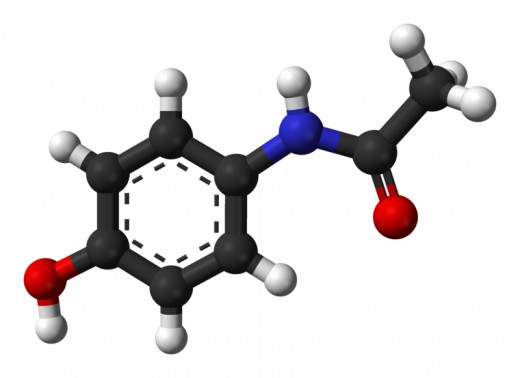Does Paracetamol (tylenol) cause Alzheimer's or memory loss?

Paracetamol, known as Tylenol® in the USA is one of the world's most popular over the counter pain killers and fever reducers. It is sold as tablets, pills, capsules and as an ingredient in various cold and flu remedies. I is safe if you use it properly but is not easy to use safely even if you follow the instructions on the box, and who reads the safety instructions inside?
Here I look at how Paracetamol works, some hints that it increases the risk of Alzheimer's disease, and how to use it safely, because sometimes it is the best, or at least least bad, form of treatment (for example it is safer for infants than aspirin) and should not be boycotted because of its known risks.
This article was inspired by Walter Last's article in Nexus Magazine February-March 2011 which is available online. It backs up an instinctive wariness of paracetamol gained from reading the safety instructions. I have not however found clear support for the claim made to me that paracetamol causes impotence. Personally I steer clear of all painkillers and especially Paracetamol as much as possible: Normally a good night's sleep is enough.
How Paracetamol works
Paracetamol, technically N-(4-hydroxyphenyl)acetamide apparently works on the brain by inhibiting the uptake of a chemical that would activate the body's pain receptors. Although it is clear it works on the brain the precise mechanism is still not clear. Basically however ( I am not a biochemist) it seems to fool the brain into not registering pain, the body's warning system.
Paracetamol, Liver and Kidneys
The liver transforms paracetamol into non-toxic products in three ways. One of these produces an intermediate product that is toxic. This product, known as NAPQI is mainly responsible for the toxicity of paracetamol. The final products are excreted by the Kidneys and in some circumstances there is a risk of kidney damage or even failure. The risk of kidney damage is not peculiar to paracetamol, it applies to other over the counter pain killers and to diabetics.
Paracetamol is much more likely to cause liver damage if taken with alcohol. Basically either can overwhelm and then damage the liver but together they are much more dangerous.
Paracetamol is the most common cause of acute liver failure in the United States and the United Kingdom, mostly by overdose and mostly unintentional. There may be no initial symptoms after an overdose but liver failure and death may result in days and a liver transplant may be needed.
It should be noted that the therapeutic dose of paracetamol is close to the lethal dose which means extreme care is needed (The same is true of heroin, and that fact was used in 1924 as one of the reasons for banning Heroin. It is not clear therefore, why heroin is banned and paracetamol is legal. As usual there is a vague smell of corruption here). There have been moves to reduce the maximum allowed safe dose of Paracetamol from the current limit of four grams which has been known to result in liver damage.
Paracetamol and Alzheimer's?
Since Paracetamol works on the brain and Alzheimer's is associated with plaques in the brain the possibility that it may increase the risk of Alzheimer's must be considered.
Walter Last's extensive article notes that Jones once took paracetamol for 10 days and noticed memory problems soon afterwards. These went away but the same pattern repeated itself ten years later prompting him to investigate paracetamol resulting in a published paper in Medical Hypotheses (2001) 56(1), 121–123 Here is the abstract
Phenacetin was implicated as a causative factor in Alzheimer’s disease (AD) in 1971. Although the chief metabolite, paracetamol, was earlier identified as responsible for its analgesic and antipyretic properties, a link with senile plaque formation does not appear to have been previously suspected. In common with paracetamol, so-called recreational drugs (RDs) likewise stimulate free radical activity, and might therefore pose a similar danger in terms of causing AD later in life. The case for regarding the brain as an even more delicate and vulnerable structure than currently believed, at risk especially from substances untested in man but of proven neurotoxicity in rodents and non- human primates, needs to be taken more seriously than at present.
A later paper by Dr Jones, presumably of similar quality was not accepted by any medical journal and is available online
Phenacetin was introduced in 1887. In 1907 Alzheimer's disease was recognised as a rare disease. No more than 12 cases were reported before 1907 and 56 more between 1907 and 1912. In 2010 there were 35 million cases worldwide. As use of Phenacetin spread so did Alzheimer's. Women take twice as much Paracetamol as men and have twice the incidence of Alzheimer's. China is currently the worlds major paracetamol producer and has the highest projected rates of Alzheimer's
Obviously Paracetamol may not be the only cause of Alzheimer's though, as with alcohol, taking it when other causes are present may increase the risk disproportionately. Mercury, for example, used in dental fillings, and flu vaccinations each year ( which also tend to contain mercury) increase the risk, for sample patients who had 5 consecutive years between 1970 and 1980 had ten times the risk of contracting Alzheimer's.
Last notes that Vitamin B3 (niacinamide) has been shown to cure mice with induced Alzheimer's. There is a lot more in Last's article which should be read (critically) by anyone taking Paracetamol.
Using Paracetamol Safely
DISCLAIMER: I AM NOT A DOCTOR, PHYSICIAN OR MEDICAL EXPERT.
These commonsense recommendations may not be valid for you: for example, if my memory has not misled me, some epileptics are required to take daily doses of paracetamol. IF IN DOUBT SEE A DOCTOR.
-
Like all painkillers use as a last resort or if directed by a doctor.
-
The recommended safe dose is 4 grams a day and 4 hours between doses up to half a gram. Set your own dose to less than this. I try for 1 gram a day
-
Limit alcohol intake with Paracetamol. Do not use it as a hangover cure.
-
Do not take it for more than ten days: if the pain won't go away see a doctor
-
Increase intake of vitamin B3 while taking paracetamol.
- Whenever you take it look at your watch and add at least 6 hours to determine the time for your next dose
- Take it half an hour before sleeping. The reduction of pain will help you sleep better and the sleep will help you heal faster.
This is not an exclusive list of precautions. See the links for more details.
In brief
Paracetomol is a well known painkiller that needs to be treated with care and respect. The simple rules given above should go a long way to reducing the risk. If in doubt consult the references here and talk to a pharmacist and physician.
- http://www.health-science-spirit.com/paracetamol.htm
Walter Last's article - Paracetamol - Wikipedia, the free encyclopedia
A solid description of paracetamol at a semi technical level. You may need to consult other sources to understand it. - KIDNEY DISORDERS - Analgesic Nephropathy (Painkillers and the Kidneys)
A useful if brief reference








